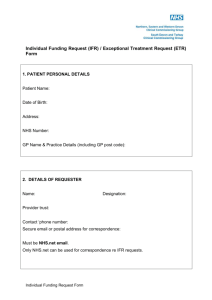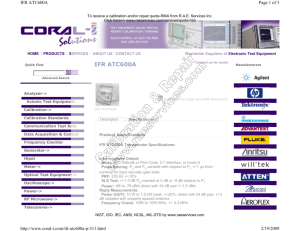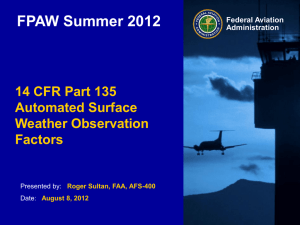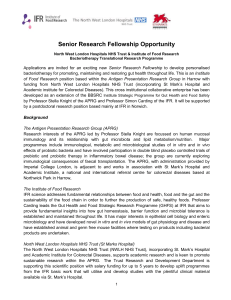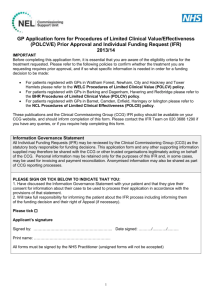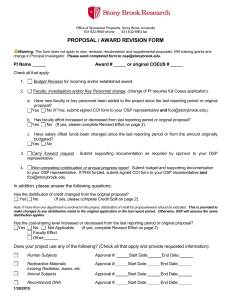Budgeting for IFR Accounts
advertisement
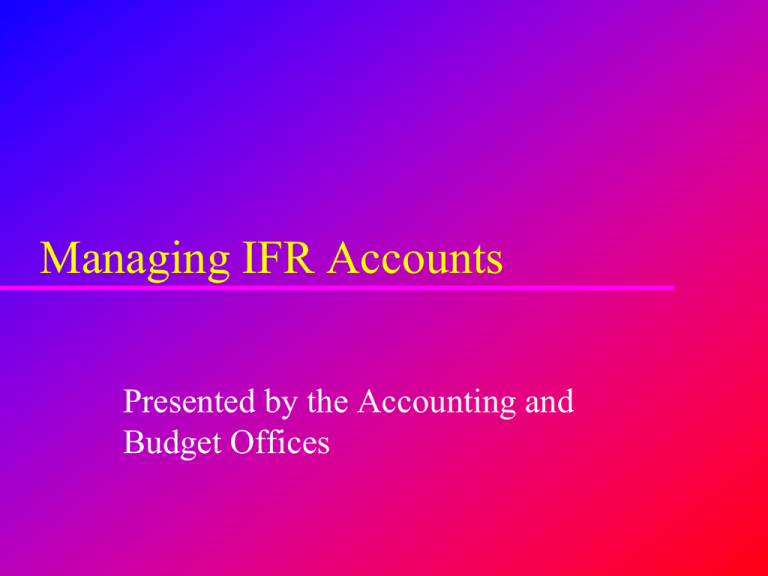
Managing IFR Accounts Presented by the Accounting and Budget Offices Training Objectives Defining what IFR Programs are. How are they funded? IFR Policies and Procedures. What kinds of reports are available? What are IFR accounts? IFR’s are self-supporting accounts that support activities related to the campus’ missions. These types of accounts have clear and defined income/expenditure relationships. A unique aspect of them is their ability to carry forward cash balances from one fiscal year to another. Fringe benefits and administration overheads are additional charges the IFR accounts must bear, except for accounts that have received appropriate waivers. How do IFR accounts acquire allocation? The Budget Office submits an IFR budget request to System Administration in Albany. Previous year’s expenditure activity is a primary determinant in deciding how much allocation a campus will receive. On top of this System Administration usually builds on an inflation factor and increases for programmatic changes (new or expanding programs) IFR worksheets are completed by account managers either online into the Campus Budget Module (CBM) system or on to hardcopy forms. The VP Coordinator reviews department’s IFR worksheets and compiles that information into a request that is reviewed by the University Budget and Accounting Offices. The Budget Office compiles each VP area’s submissions into a campus file which is transmitted to Albany. System Overview IFR Policies and Procedures General IFR Guidelines: IFR accounts should basically have one purpose and one revenue source. Don’t forget to budget for the overhead and fringe benefit charges your accounts may be liable for. – IFR administrative overhead charges are assessed on IFR revenue rather than expenses. – Fringe Benefits are assessed on expenses. IFR account will need $54,872 in revenue to cover a $30,000 in Personal Service: $30,000 Personal Service $30,000 x 55.48% $16,644 in Fringe Benefit ($30,000 +16,644)x 17.64% $ 8,228 in Administrative Overhead IFR Policies and Procedures General IFR Guidelines – cont’d: Remember it is the allocation balance in your account which allows you to expend funds – Not the cash balance in the account. IFR Policies and Procedures - cont’d Key Points of Stony Brook’s IFR Deficit Policy: IFR accounts should maintain positive accrued cash balances. The expenses charged to an IFR account should be covered by the revenue which that account takes in. IFR accounts which develop cash deficits as of 6/30 will have one year to eliminate that deficit. If the deficit is not eliminated in that year the Budget Office may reduce that VP area’s state allocation. This is NOT something that a Vice President would like to have done to their budget…. The President does NOT like to hear that IFR accounts have been allowed to be run into deficit conditions. Reports Online inquiries – SMRT Monthly reports – Account Expenditure Summary (AES) – SMRT Month-End Management Report Any questions? Just ask. Any questions? Just ask. Q. When, should an IFR account be used? Stony Brook Foundation (SBF) account? Faculty, Student Association (FSA) account? Research Foundation Service and Facility (S&F) account? A. An IFR account should be used when ever the activity is state activity. All activity should go through an IFR unless there is an approved exception as stated below. SBF accounts should only be used when the revenue is from gifts or contributions. FSA accounts should be used for a) one-time events of short duration, i.e. conferences; b) benefit of individual students, faculty or staff members or appropriately recognized organizations; c) may not be used when funds are state. S&F accounts should be used when activity is 100% research-highly technical research. May include some third party activities. Any questions? Just ask. Q. How do I open an IFR account? A. Along with your VP coordinator: Determine what the account is to be used for. How much revenue will this account generate? What will your expenses (budget) be? This information should be shown on the “IFR Allocation Worksheet” (see web link). Upon VP approval, the VP coordinator will submit the request to Accounting for processing. Accounting will inform you and all interested parties once the account has been created. 1) 2) 3) Any questions? Just ask. If the IFR account will be for a service that you will be charging a user fee, there are additional steps: 1) Determine what the account /service is for. 2) Obtain approval from your Dean or Chairperson 3) Submit request to VP area for approval. 4) Contact Accounting (Kathie Diehl) to work with the account director to determine the user fee. This will be achieved by determining the projected annual expenses and the annual unit of service (i.e. annual hours, annual analyses). This information will be input on the rate schedule (see attached) to determine the rate. 5) Once the rate has been calculated, it is then submitted to the VP area for their review and approval. The VP coordinator will request Accounting to create the account. 6) Accounting will submit to the University Controller for final approval. 7) While awaiting the University Controller’s approval, Accounting will submit the request to the SUNY System Administration to create the account. 8) Upon final approval, Accounting will inform you and all interested parties of the account. Any questions? Just ask. Q. What are the fringe benefit and overhead rates? A. The Office of the State Comptroller (OSC) and the Division of Budget analyze the actual fringe benefit costs on an annual basis. After the rate is computed, OSC notifies all state agencies of the rate specific to a fiscal year and agency. The Fringe Benefit rate is assessed on expenditures. [Exception: SUTRA Summer and Winter accounts have fringe assessed on revenue.] Revenue, not expenditures, is the basis for charging IFR Overhead assessments. State Fringe Benefit Federal Fringe Benefit Overhead Assessments Fiscal Year 12/13 51.68% 50.16% 15.00% Fiscal Year 13/14 55.48% 58.75% 15.00% Any questions? Just ask. Q. A. How is the assessment charged to the account? Fringe benefits are assessed on expenditures, except for SUTRA Summer and Winter accounts. The IFR Overhead assessment is charged on the revenue. As the revenue is deposited to your account, the assessment is charged. The charge is a direct reduction to your account’s cash balance. It DOES NOT affect your account’s allocation. Any questions? Just ask. Q. My account has plenty of cash, yet Purchasing says I do not have enough money for my order. Please explain. A. When Purchasing processes a purchase order, they make an encumbrance against your account’s allocation, NOT your cash. When you request your account’s initial allocation, your request should be based on your anticipated annual revenue and expenditures. If your cash is greater than anticipated, you may request, through your VP coordinators and ultimately the Accounting Department, additional allocation. Basically, you need your allocation to spend your cash, and you need your cash to get your allocation! Any questions? Just ask. Q. How come it seems to take so long to see my cash deposits? A. All deposits are made at the campus Bursar’s Office. Every 15th and 30th (or 31st) of the month a revenue summary report is generated identifying the total of all deposits made to each account. The Accounting Office reviews this report and subsequently enters the revenue information into the SUNY system. When you look at your AES report’s cash page or the SUNY system, the cash amounts reflected for each month are for the last 15 days of the prior month and the first 15 days of the current month. For example, if you look at the month of January, the cash would be for the periods of December 16–31, and January 1-15. Any questions? Just ask. Q. How do I know the detail of the total cash per month? A. Along with your AES reports, each IFR account receives a copy of the IFR Collections Analysis report. This gives the detail information. Any questions? Just ask. Q. An error was made and a deposit went into the wrong account. How can I get it corrected? A. Just contact or e-mail Kathie Diehl or Joan Petrick in the Accounting Department explaining the error and indicate the correct account. Accounting will process a transfer of cash between the accounts. A transfer of cash may generate assessments. Any questions? Just ask. Q. Unspent allocation was removed from my account. How can they take my money? A. When IFR allocation is in short supply and projections indicate that you will not require all of your requested allocation, some may be transferred to other accounts that are short at the VP coordinator’s discretion. This does not mean that your money has been taken; your cash balance is unaffected. Any questions? Just ask. Q. There was unspent allocation at the end of the year. Did I lose that money? A. Unlike State Purpose funds, IFR accounts do not “lapse.” Although the allocation is unspent, the cash balance rolls forward, and is one of the factors used to determine the account allocation for the following year. Any questions? Just ask. Q. Why do I have to keep a log of all usage of the services my center provides? A. An account director is responsible for keeping logs of all information supplied on the rate schedule for the service center. This includes the expenses as well as the annual units. The information maintained in the logs will be required during the campus rate review process. This is an audit requirement. Any questions? Just ask. Q. What is Excess External Revenue and why must I keep a log for the collection of Excess External Revenue? A. Excess External Revenue is the revenue collected in excess of the external rate. (Revenue in excess of break even point – Profit) * The excess external revenue may be kept by the department and used at the department’s discretion. The account director is responsible for maintaining logs, which identify the amount of external revenue collected. During the rate review process the logs are used to identify the amount of external revenue, which may be contained in the account balance. This is also an audit requirement. Office Contacts Initial Allocation/Campus Budget Module (CBM) – Diane Thide Midyear Budget Office 2-6090 Allocation Adjustments – Kathie Diehl Accounting Office Revenue/Expense 2-6040 Questions – Kathie Diehl Accounting Office – Joan Petrick Accounting Office – Lolita Sung Accounting Office 2-6040 2-1304 2-5716 Web Links IFR Accounting (Manual, Worksheets, Contacts) http://www.stonybrook.edu/accounting/ifr Introductions to State Accounts http://www.stonybrook.edu/accounting/help/state_accounts.shtml Allocation and Expenditure Object codes http://naples.cc.sunysb.edu/Admin/HRSForms.nsf/pub/ACTD0012 SMRT User Manual http://www.stonybrook.edu/budgetoffice/management.shtml ACCOUNTING OFFICE CONTACTS KATHIE DIEHL SENIOR FINANCIAL MANAGER STATE AND IFR ACCOUNTING JOAN PETRICK LOLITA SUNG INCOME FUND REIMBURSABLE (IFR) ACCOUNTING INCLUDING REVENUE, OVERHEAD ASSESSMENTS AND RATE SCHEDULES EXPENDITURE ACCOUNTING www.accounting.sunysb.edu For valuable information regarding Accounting Services, please check out our website. ACCOUNTING OFFICE 632-6040 GUIDE TO PROBLEM RESOLUTION BUDGET ALLOCATIONS - FORM 1 ALLOCATIONS - INTERCHANGE 2-6090 ACCOUNTING REPORT INQUIRIES JOURNAL ENTRIES ALLOCATION CHANGES 2-6040 PROCUREMENT REQUISITIONS, PURCHASE ORDERS VOUCHERS VENDOR CALLS CLARIFICATION OF FREIGHT CHARGES (OBJ CODE 5010) PETTY CASH TRANSACTIONS 2-6010 BURSAR CASH RECEIPT INQUIRIES (IFR COLLECTION ANALYSIS) 2-9316 HUMAN RESOURCES APPOINTMENT DISCREPANCIES 2-6140 PAYROLL QUESTIONS - OVERTIME, STANDBY 2-6180
